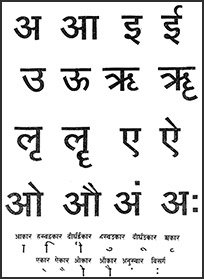Gamya: 16 definitions
Introduction:
Gamya means something in Hinduism, Sanskrit, Marathi, Hindi. If you want to know the exact meaning, history, etymology or English translation of this term then check out the descriptions on this page. Add your comment or reference to a book if you want to contribute to this summary article.
Alternative spellings of this word include Gamy.
In Hinduism
Shilpashastra (iconography)
Source: archive.org: Illustrations of Indian Music and Dance in Western Indian StyleGamya (गम्य) refers to one of the forty-seven tānas (tone) used in Indian music.—The illustration of Gamya (as a deity) according to 15th-century Indian art is as follows.—The colour of his body is yellow. His face is similar to the face of a bull. A viṇā is in his right hand and left hand is in Pravacana-Mudrā.
The illustrations (of, for example Gamya) are found scattered throughout ancient Jain manuscripts from Gujarat. The descriptions of these illustrations of this citrāvalī are based on the ślokas of Vācanācārya Gaṇi Sudhākalaśa’s Saṅgītopaniṣatsāroddhāra (14th century) and Śārṅgadeva’s Saṅgītaratnākara (13th century).

Shilpashastra (शिल्पशास्त्र, śilpaśāstra) represents the ancient Indian science (shastra) of creative arts (shilpa) such as sculpture, iconography and painting. Closely related to Vastushastra (architecture), they often share the same literature.
Vyakarana (Sanskrit grammar)
Source: Wikisource: A dictionary of Sanskrit grammarGamya (गम्य).—To be understood, not expressed; cf. यस्यार्थो गम्यते न च शब्दः प्रयुज्यते स गम्यः। (yasyārtho gamyate na ca śabdaḥ prayujyate sa gamyaḥ|) com. on Hem. II. 2. 62.

Vyakarana (व्याकरण, vyākaraṇa) refers to Sanskrit grammar and represents one of the six additional sciences (vedanga) to be studied along with the Vedas. Vyakarana concerns itself with the rules of Sanskrit grammar and linguistic analysis in order to establish the correct context of words and sentences.
Purana and Itihasa (epic history)
Source: archive.org: Shiva Purana - English TranslationGamya (गम्य) refers to “one who is approachable through (the path of good conduct)”, according to the Śivapurāṇa 2.5.2 (“The Prayer of the gods).—Accordingly, as the Gods eulogized Śiva: “[...] O Śiva, obeisance to Thee of the form of virtue, to the Sattva, to the Ātman of Sattva. Obeisance to thee whose form is knowable through the Vedas. Obeisance to thee, the beloved of the Vedas. Obeisance to Thee whose form is the Veda, obeisance to the reciter of the Vedas. Obeisance to Thee who traversest the path of good conduct and who art approachable through the path of good conduct (sadācārādhva-gamya). [...]”.

The Purana (पुराण, purāṇas) refers to Sanskrit literature preserving ancient India’s vast cultural history, including historical legends, religious ceremonies, various arts and sciences. The eighteen mahapuranas total over 400,000 shlokas (metrical couplets) and date to at least several centuries BCE.
Languages of India and abroad
Marathi-English dictionary
Source: DDSA: The Molesworth Marathi and English Dictionarygamya (गम्य).—a (S) Accessible or attainable, lit. fig.; to be approached, passed, traveled. 2 Goable, reachable, i. e. knowable. Ex. of comp. anumānagamya, abhyāsagamya, anubhavagamya, indriyagamya, paricayagamya, buddhi- gamya, vicāragamya, vyavahāragamya Cognizable or intelligible--upon inference--through the senses or faculties--through or upon practice--by experience--upon conversancy or acquaintance with--by the force of understanding--through consideration or reflection--through commerce or business, or through transacting or performing. Many others occur, more or less valuable; as upadēśagamya Knowable upon instruction afforded; that requires to be explained or taught; gurūgamya That demands a Guru or teacher; bhāvagamya Knowable through love and attachment of the heart; vādagamya Knowable upon argumentation or discussion; śāstragamya Knowable from the Shastras; śramagamya or sādhanagamya Knowable through exertion or toil, or through instruments, measures, means; adhyayanagamya, arthagamya, upabhōgagamya, tarkagamya, nirṇayagamya, jñānagamya, and others not needing particular explanation. Of the above some few will be found in order; but the general sense and power of the compound and the rule of formation must be learned here. 3 Used as s n Ingress or insight into; acquaintance with (a branch of knowledge).
Source: DDSA: The Aryabhusan school dictionary, Marathi-Englishgamya (गम्य).—a Accessible. Knowable, as anumāna- gamya n Insight into.
Marathi is an Indo-European language having over 70 million native speakers people in (predominantly) Maharashtra India. Marathi, like many other Indo-Aryan languages, evolved from early forms of Prakrit, which itself is a subset of Sanskrit, one of the most ancient languages of the world.
Sanskrit dictionary
Source: DDSA: The practical Sanskrit-English dictionaryGamya (गम्य).—pot. p.
1) Accessible, approachable, obtainable; या गम्याः सत्सहायानाम् (yā gamyāḥ satsahāyānām) Kirātārjunīya 11.22.
2) Intelligible, or easy to be comprehended.
3) Intended, implied, meant.
4) Suitable, desirable, fit; गम्यं त्वभावे दातॄणां कन्या कुर्या- त्स्वयंवरम् (gamyaṃ tvabhāve dātṝṇāṃ kanyā kuryā- tsvayaṃvaram) Y.1.64.
5) Fit for cohabitation; दुर्जनगम्या नार्यः (durjanagamyā nāryaḥ) Pañcatantra (Bombay) 1.278; अभिकामां स्त्रियं यश्च गम्यां रहसि याचितः । नोपैति (abhikāmāṃ striyaṃ yaśca gamyāṃ rahasi yācitaḥ | nopaiti) Mb.
6) Curable (by a drug &c.); न गम्यो मन्त्राणाम् (na gamyo mantrāṇām) Bhartṛhari 1.89.
-myaḥ A man with whom a woman may have intercourse, a libidinous or voluptuous man, lover, paramour; Daśakumāracarita 41.
Source: Cologne Digital Sanskrit Dictionaries: Edgerton Buddhist Hybrid Sanskrit DictionaryGamya (गम्य).—adj., belonging to, property of (with gen.): [Page210-b+ 71] Divyāvadāna 42.28 (yasya nāmnā vahanaṃ) saṃsiddhayānapātram āgacchati tat tasya gamyaṃ bhavati; 232.26 (after almost the same first clause) tasyaiva tāni ratnāni gamyāni; 243.19 (etat suvarṇam) asmākaṃ gamyam.
Source: Cologne Digital Sanskrit Dictionaries: Shabda-Sagara Sanskrit-English DictionaryGamya (गम्य).—mfn.
(-myaḥ-myā-myaṃ) 1. Attainable, accessible. 2. To be gone, to be gone to. 3. Perceptible. 4. Desirable, suitable, fit. E. gam to go, yat aff.
Source: Cologne Digital Sanskrit Dictionaries: Cappeller Sanskrit-English DictionaryGamya (गम्य).—[adjective] to be approached or entered, accessible (also for sex. intercourse), attainable to ([genetive], [locative], or —°), possible, fit, proper; to be guessed or understod, perceptible, intelligible. Abstr. tā [feminine], tva [neuter]
Source: Cologne Digital Sanskrit Dictionaries: Monier-Williams Sanskrit-English Dictionary1) Gamya (गम्य):—[from gam] a mfn. to be gone or gone to, approachable, accessible, passable, attainable (often a- [negative]), [Mahābhārata] etc.
2) [v.s. ...] to be fixed (as to the number, saṃkhyayā), countable, [Ṛgveda-prātiśākhya xiv, 28]
3) [v.s. ...] accessible to men (a woman), fit for cohabitation, [Yājñavalkya ii, 290; Mahābhārata i; Bhāgavata-purāṇa i, etc.]
4) [v.s. ...] (a man) with whom a woman may have intercourse, [v]
5) [v.s. ...] libidinous, dissolute, [Daśakumāra-carita vii, 32]
6) [v.s. ...] ‘easily brought under the influence of (a drug)’, curable by ([genitive case]), [Bhartṛhari i, 88]
7) [v.s. ...] approaching, impending, [Gaṇitādhyāya; Golādhyāya]
8) [v.s. ...] to be perceived or understood, intelligible, perceptible, [Manu-smṛti xii, 122; Meghadūta] etc.
9) [v.s. ...] intended, meant, [cf. Lexicographers, esp. such as amarasiṃha, halāyudha, hemacandra, etc.]
10) [v.s. ...] desirable, suitable, fit, [Yājñavalkya i, 64.]
11) b etc. See √gam.
Source: Cologne Digital Sanskrit Dictionaries: Yates Sanskrit-English DictionaryGamya (गम्य):—[(myaḥ-myā-myaṃ) a.] Attainable; accessible; fit. f. myā A whore.
Source: DDSA: Paia-sadda-mahannavo; a comprehensive Prakrit Hindi dictionary (S)Gamya (गम्य) in the Sanskrit language is related to the Prakrit word: Gamma.
[Sanskrit to German]
Sanskrit, also spelled संस्कृतम् (saṃskṛtam), is an ancient language of India commonly seen as the grandmother of the Indo-European language family (even English!). Closely allied with Prakrit and Pali, Sanskrit is more exhaustive in both grammar and terms and has the most extensive collection of literature in the world, greatly surpassing its sister-languages Greek and Latin.
Hindi dictionary
Source: DDSA: A practical Hindi-English dictionary1) Gamya (गम्य) [Also spelled gamy]:—(a) accessible, approachable, attainable; hence ~[tā] (nf).
2) Gamyā (गम्या):—(a) fit for coition; cohabitable (woman).
...
Kannada-English dictionary
Source: Alar: Kannada-English corpusGamya (ಗಮ್ಯ):—
1) [adjective] that can be approached, reached, entered, etc.
2) [adjective] that can be easily understood; knowable; intelligible.
3) [adjective] fit for cohabitation or sexual relation.
--- OR ---
Gamya (ಗಮ್ಯ):—[noun] the place toward which someone or something intends or has to go, is going or sent; the destination.
Kannada is a Dravidian language (as opposed to the Indo-European language family) mainly spoken in the southwestern region of India.
See also (Relevant definitions)
Starts with: Gamyadi, Gamyagamakabhava, Gamyagamya, Gamyamana, Gamyasthana, Gamyata, Gamyatana, Gamyate, Gamyatva, Gamyavadu.
Ends with (+33): Abhigamya, Abhyasagamya, Abodhagamya, Adhigamya, Adhvagamya, Agamya, Akshigamya, Anadhigamya, Anagamya, Anubhavagamya, Anugamya, Anumanagamya, Aparagamya, Arthagamya, Avagamya, Bhaktigamya, Bhavagamya, Bodhagamya, Buddhigamya, Dhyanagamya.
Full-text (+60): Agamya, Jnanagamya, Gamma, Abodhagamya, Vyakhyagamya, Anugamya, Buddhigamya, Agamyagamaniya, Dhyanagamya, Bodhagamya, Yajnagamya, Bhaktigamya, Bhavagamya, Manogamya, Agamyagamana, Agamyagamin, Gamyatva, Upagamya, Abhigamya, Agamyarupa.
Relevant text
Search found 28 books and stories containing Gamya, Gamyā; (plurals include: Gamyas, Gamyās). You can also click to the full overview containing English textual excerpts. Below are direct links for the most relevant articles:
Garga Samhita (English) (by Danavir Goswami)
Verse 1.11.12 < [Chapter 11 - Description of Śrī Kṛṣṇacandra’s Birth]
Verse 8.13.108 < [Chapter 13 - A Thousand Names of Lord Balarāma]
Shrimad Bhagavad-gita (by Narayana Gosvami)
Verse 13.18 < [Chapter 13 - Prakṛti-puruṣa-vibhāga-yoga]
Verse 13.19 < [Chapter 13 - Prakṛti-puruṣa-vibhāga-yoga]
Brihad Bhagavatamrita (commentary) (by Śrī Śrīmad Bhaktivedānta Nārāyana Gosvāmī Mahārāja)
Verse 1.5.119 < [Chapter 5 - Priya (the beloved devotees)]
A History of Indian Philosophy Volume 1 (by Surendranath Dasgupta)
Part 9 - Inference < [Chapter IX - Mīmāṃsā Philosophy]
Sahitya-kaumudi by Baladeva Vidyabhushana (by Gaurapada Dāsa)
Text 10.191 [Sūkṣma] < [Chapter 10 - Ornaments of Meaning]
Text 2.3 < [Chapter 2 - The Natures of Words (śabda)]
Text 10.242 < [Chapter 10 - Ornaments of Meaning]
Rig Veda (translation and commentary) (by H. H. Wilson)
Rig Veda 1.163.13 < [Sukta 163]